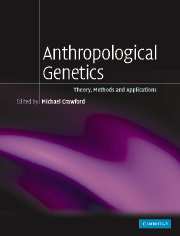Chapter 1 - Foundations of Anthropological Genetics
Published online by Cambridge University Press: 05 June 2012
Summary
What is anthropological genetics?
Anthropological genetics is a synthetic discipline that applies the methods and theories of genetics to evolutionary questions posed by anthropologists. These anthropological questions concern the processes of human evolution, the human diaspora out of Africa, the resulting patterns of human variation, and bio-cultural involvement in complex diseases. How does anthropological genetics differ from its kin discipline, human genetics? Both fields examine various aspects of human genetics but from different perspectives. With the synthetic volume of 1973 (Methods and Theories of Anthropological Genetics), it became evident that the questions posed by the practitioners of anthropological genetics and human genetics tended to be somewhat different. I compared and contrasted these two fields in the introduction to the special issue of Human Biology (2000) on Anthropological Genetics in the twenty-first century (see Table 1.1). What distinguishes anthropological genetics from human genetics is its emphasis on smaller, reproductively isolated, non-Western populations, plus a broader, biocultural perspective on evolution and on complex disease etiology and transmission. Judging from the contents of the American Journal of Human Genetics (premiere journal in the field of human genetics) there is a greater emphasis on the causes and processes associated with disease, and the examination of these processes in affected phenotypes (probands) and their families. Anthropological geneticists tend to focus more on normal variation in non-Western reproductively isolated human populations (Crawford, 2000).
- Type
- Chapter
- Information
- Anthropological GeneticsTheory, Methods and Applications, pp. 1 - 16Publisher: Cambridge University PressPrint publication year: 2006



